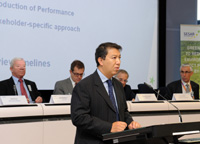 Providing a simpler, more readable and useable updated European Master Plan which takes into account recent changes in the aviation sector, is the aim of the SESAR JU’s ongoing Master Plan update campaign. Started in October 2011, the first draft document will be available for consultation in March 2012.
Providing a simpler, more readable and useable updated European Master Plan which takes into account recent changes in the aviation sector, is the aim of the SESAR JU’s ongoing Master Plan update campaign. Started in October 2011, the first draft document will be available for consultation in March 2012.
On 30 March 2009 the European Union Transport Council endorsed the first European Air Traffic Management Master Plan. It provided a roadmap for the development and deployment of the SESAR Definition phase outcome and for the first time presented all elements of European air traffic management together in a single document.
The Master Plan was always designed to evolve, and now, three years later, the first major update is being undertaken, with the all-important emphasis on deployment of the future European ATM system.
Launched in Brussels in October 2011, the updated Plan is urgently required to respond to the rapidly changing air traffic situation, as well as to take account of recent developments in ATM technology. “Since the adoption of the current Master Plan, important parameters have changed. We’re updating the Plan, carefully taking into account these latest developments”, says Denis Koehl, SESAR JU Senior Military Advisor in charge of the update campaign.
 Deployment synchronisation
Deployment synchronisation
The first SESAR Master Plan brought European ATM stakeholders together to produce and validate a document representing a common view of the future of European ATM. This remains a central theme and the update will call for a “stakeholder-specific approach”, meaning that by the time it is published, each participant should “know what the Master Plan means for them, what is expected from them and how it will affect them,” says Patrick Ky, Executive Director of the SESAR JU. He stresses the need for total stakeholder involvement in the update process, but adds that while “not everybody will agree with everything, there will be no-one at the end who can say they were not consulted.”
When updating the Master Plan, the SESAR JU follows three core principles: to produce a simpler, more readable and useable document; to give stakeholders greater input; and to emphasise the need to deliver results in a more timely and efficiently manner. Performance linkages will be introduced to ensure that individual components in the Plan contribute to the overall performance of the future ATM system.
Another focus of the update is the synchronisation between deployment dates for different stakeholder groups. “The main idea is to motivate all SESAR stakeholders to think about the deployment of improvements,” says Patrick Mana, Programme Manager at the SESAR Joint Undertaking. “The Plan will propose ideas for deployment from the stakeholder point of view. By synchronising the introduction of SESAR’s solutions, we expect a maximisation of performance benefits and consequently of the value of investment.“
The global financial crisis came about after the first Master Plan was published. The update now aims at ensuring that the measures make good business sense. “The Master Plan is the living link between development activities and deployment decisions,” says Ky. “We cannot afford any more to deploy systems without a clear and validated impact assessment.”
Proposals for deployment of the initial measures are already being considered. “We’re looking at things like traffic synchronisation, four-dimensional trajectory management, controlled time of arrival, runway throughput and network management,” says Koehl. “These have the priority, but they rely on important enablers such as information management, communications, navigation and surveillance, datalinking, ADS-B and so on.”
Update process
The first part of the update campaign was carried out by ECAC experts. It focussed on a total review of technical information contained in the current ATM Master Plan and performance needs were evaluated for all operational environments such as airports, en-route and TMA operations. Safety, cost-effectiveness and flight efficiency targets were also addressed in the overall network context.
The second part of the campaign took place between January and March and focussed on the development of the high-level Master Plan (so called Executive level) document. Four draft versions are planned, the third of which will be released by end of February for informal consultation by stakeholders.
The document has three main parts:
Performance View: An updated Strategic Objective reviewed by the European Commission’s Single Sky Committee, restating the 2005 objectives of a three-fold increase in ATM capacity, safety performance increased by a factor of 10, a 10 percent reduction in emissions and a halving of ATM costs to the user. This section also contains Strategic Performance Needs, a series of non-binding requirements to be used as the basis for the deployment view.
Deployment View: This is the main part of the document, focussing on around 10 “Essential Changes” to SESAR Step 1, which bring significant performance benefits. Each Essential Change has an overview detailing the system changes for each stakeholder group. This chapter also contains the links between the ICAO Aviation System Block Upgrades and SESAR changes at the level of Operational Focus Area.
Business View: Providing an overview of the costs and associated benefits for each stakeholder group.
The updated Plan will be subject to approval by the SESAR JU Administration Board during the summer. It will then be used as a reference document for the ICAO's Twelfth Air Navigation Conference (ANC 12) in Montreal in November, where it will represent the European input to ICAO’s Global Air Navigation Plan.

